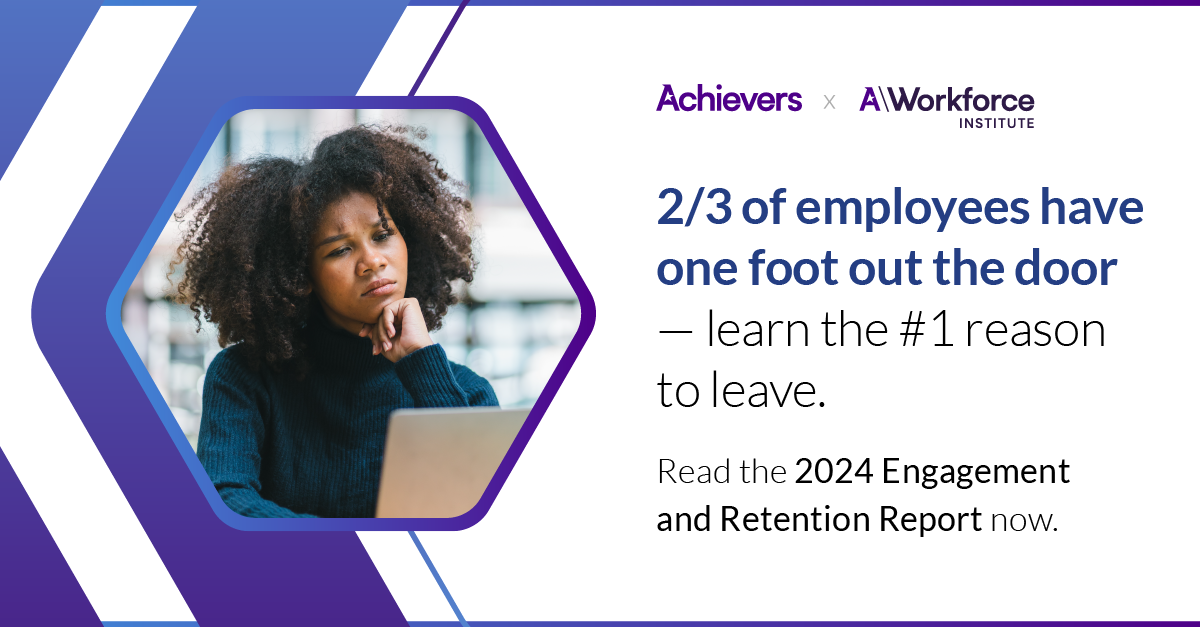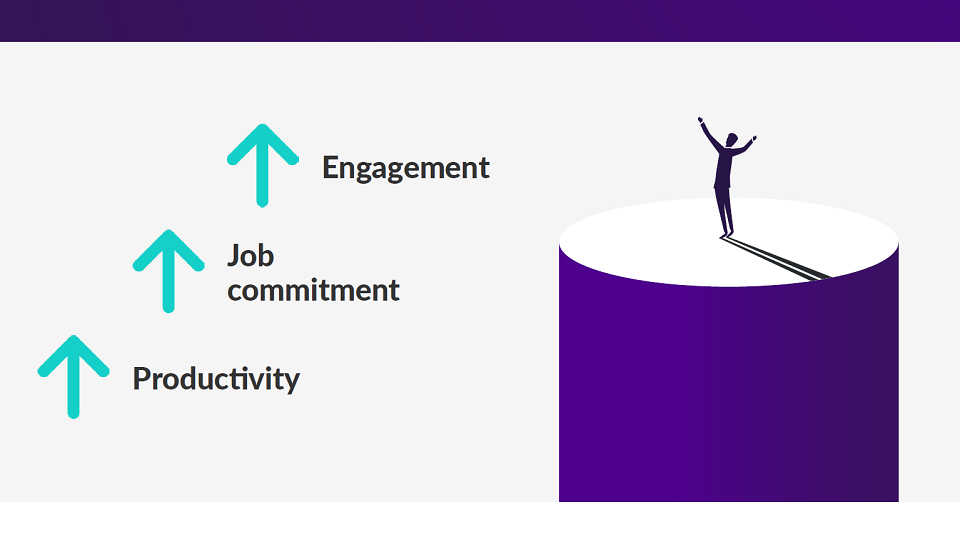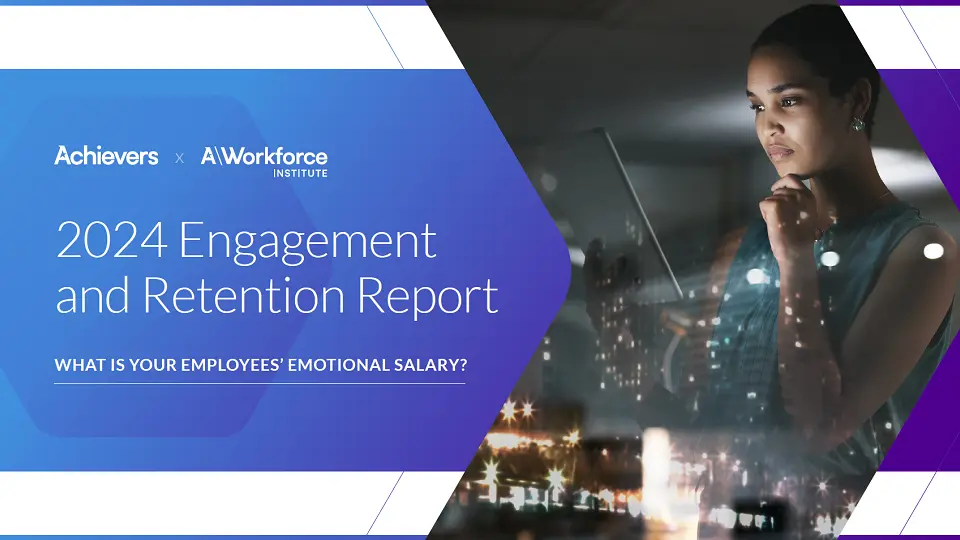Table of contents
In the 7th annual Engagement and Retention Report from Achievers Workforce Institute, the number one reason employees gave for job hunting in 2024 is better compensation. What does that mean for business leaders who need to attract, motivate, and retain with tight payroll budgets?
The focus on compensation is new — historically career progression has been the top reason, and in 2023 work flexibility jumped to the top spot. With cost of living and inflation increases making waves across the world, it’s not surprising that we’re seeing that impact employee expectations. However, it’s not the whole story.
Motivate beyond money: non-financial incentives
For employees who say they can live comfortably on their income, compensation drops back to a distant third position, behind career progression and work flexibility. This means that when employees can meet their basic needs, they can prioritize other things. The opportunity for HR leaders is to create an employee experience that motivates and retains beyond base pay.
What are non-financial incentives?
Non-financial incentives are all the components of work aside from base pay. That’s includes everything from work-life balance and career development to frequent recognition and the right employee benefits. At AWI, we call this aspect of employee experience “emotional salary”, and our research shows that once employees earn a living wage, emotional salary becomes increasingly important for attraction and retention.
Work-life balance: Embracing the whole person
Work-life balance has been a point of discussion for decades, but the COVID pandemic put a spotlight on flexibility. Employees who experienced increased balance and flexibility during the crisis are not willing to compromise, as shown by the AWI finding that work flexibility is the number one reason to stay in a job.
What is work-life balance?
Work-life balance or flexibility can mean different things for different people, roles, and industries. For some it may be about working wherever and whenever they want, while for frontline workers it often means some control over shifts and adequate paid leave.
Why does work-life balance matter?
Work-life balance matters because employees who feel able to balance all the parts of their life are more likely to be productive and focused at work. These workers are also more likely to stay at the company because they feel they can manage all aspects of their life without having to drop everything for work.
Bespoke employee benefits: Beyond the basics
Employee benefits have evolved from health and dental — now considered table stakes in many industries — to increasingly specific benefits such as fertility care, caregiving support, pet care, and more. Employees want benefits that support their needs and will stick around for benefits that are meaningful to them.
How can I personalize employee benefits while containing costs?
Personalizing benefits while containing costs is a common ask and the first recommendation is to offer pick and mix benefits, where employees can choose the package that fits their needs. For example, pet ownership is growing faster than parenthood, so offering a choice between childcare support and pet insurance could make sense for your employees.
Which employee benefits have the biggest impact on retention?
The employee benefits that have the biggest impact on retention include paid vacation time, childcare support, and, perhaps unexpectedly, pet insurance. In 2023, AWI asked workers what benefits they received and also about their job hunting behavior. The results showed that unlimited vacation increased job commitment by 53%, childcare by 43%, and pet insurance by 38%.

What mental health benefits should employers offer?
Employers that want to support employee mental health should offer supportive time off policies, a therapy stipend, and physical wellness support. The conversation around mental health is active and evolving. Post-pandemic, employees are more stressed than ever with a Gallup study finding 44% of global workers feel stressed — a high set in 2021, which has not dropped since.
Anxiety and depression are very common mental illnesses, affecting up to a third of workers, including half of US young people aged 18-24 and 38% of those aged 25-49. Unsupported, these employees are more likely to be absent or unproductive. However, creating a culture of support and trust can improve both these metrics. In fact, a 2023 study finds that mental health programs have a $4 return for every $1 spent.
Maximize morale: Strategic recognition and rewards
Frequent, meaningful recognition is the most accessible tool for improvement and change available to business leaders, but are you using recognition strategically? An impactful recognition program is an engine — if you’re pointing it at the ground then you’re making a lot of noise but not getting closer to your goals. When business leaders unite behind one objective and use recognition strategically, the return on investment will be huge.
How can I use employee recognition to drive business results?
Use employee recognition to drive business results by identifying the behaviors and actions that will have impact and concentrating recognition efforts on those behaviors. Whether that’s efficiency, safety, connection, or something else specific to your organization, an employee recognition app can help you streamline and focus these efforts. Recognition has the biggest impact when it’s used across silos and functions to align culture and behaviors.
What kind of employee recognition motivate and retain employees?
Many kinds of employee recognition motivate and retain employees, from manager and peer to social and monetary. While companies often think they have to offer cash or gift cards for a recognition to be meaningful, AWI research shows that social recognition has the same impact as monetary recognition. A rich culture of recognition will include both social and monetary recognition, as well as up, down, and sideways!
Career progression for all: Everyone’s path is unique
Career progression is an important driver of attraction and retention, but few companies are doing it well. Only 25% of people say their company promotes from within for senior roles and even fewer (13%) see people who look and identify like them getting promoted internally.

People who see promotion equity are more than twice as likely to say they can see themselves having a long career at their company and are almost twice as likely to say they rarely think about job hunting and are productive at work.
Why do employees think promotions are unfair?
Employees think promotions are unfair because they don’t see the people they think deserve it being promoted. This could be based on reality or perception. Gather data on what is really happening and what employees feel is happening. The first will tell you whether you have a leaky leadership pipeline, empowering you to take action. The second, employee perception, will show whether there is a gap between who is actually being promoted and who is being seen to be promoted. If career progression equity is good at your company, but no one knows, then you have a communication issue, not a professional development issue.
How can HR leaders foster a skills-based growth culture?
HR leaders can foster a skills-based growth culture by viewing development and progression as aligned to but separate from promotion. When we reframe career growth to career fulfillment, we can find opportunities to support every employee’s unique desires and skills. From identifying hidden skills and skill gaps to homing in on the skills most important for individual, team, and organizational success, a skills-based organization looks beyond job title to the individual contributions and true potential. HR leaders are forging new paths by using tools like AI, recognition platforms, and performance reviews to track unknown and underutilized employee skills.
What can HR do to engage and retain employees in 2024?
To engage and retain employees in 2024, HR can focus on the right non-financial incentives to drive emotional salary so employees feel valued and rewarded beyond base pay. The 2024 Engagement and Retention Report finds five specific drivers of emotional salary: culture alignment, recognition, work relationships, employee feedback, and career equity. This type of holistic approach to employee engagement, motivation, and retention will have more long-term impact than focusing on base pay alone.
Get the 2024 Engagement and Retention Report now for the latest workforce trends and fresh best practices for the year to come.





